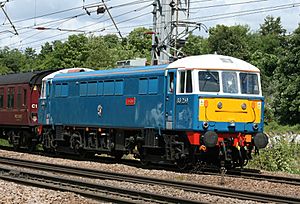Electric locomotive facts for kids
An electric locomotive is a type of train engine that runs on electricity. These powerful machines are usually cheaper to buy and run compared to other types of locomotives. However, setting up the special power system for them, called a railway electrification system, is very expensive. Because of this, only busy train tracks usually get this special power system. That's why diesel locomotives are more common, but electric ones are still very popular.
Contents
How Electric Locomotives Get Power
Electric locomotives get their power in a few main ways:
- From wires above the tracks (called overhead lines or catenary).
- From batteries built right into the train.
- From a special rail next to the main tracks (called a third rail).
Overhead Lines
Many electric trains get their power from overhead lines. These are wires suspended above the tracks. A special arm on top of the train, called a pantograph, touches these wires to collect the electricity. This is a common way to power trains on long-distance routes.
Third Rail
In some places, especially in subway systems or urban areas, trains get power from a "third rail." This is an extra rail placed next to the main tracks. A shoe-like device on the train slides along this rail to pick up electricity. It's often used where overhead wires might be difficult to install.
Battery Power
Some electric locomotives run on batteries built right into them. These are called battery-electric locomotives. They are often used in places like mines, tunnels, or train yards. This is because they don't produce exhaust fumes, which makes them safer to use in enclosed spaces.
Types of Electric Locomotives
There are many different kinds of electric locomotives, designed for various jobs. Some are built for speed, like those used for high-speed passenger trains. Others are made for pulling very heavy freight trains over long distances.
Electric locomotives have been around for a long time. Early designs used direct current (DC) power, while newer ones often use alternating current (AC) power. Modern electric locomotives are very efficient and can be quite fast. For example, the Siemens ES64U4 set a speed record for electric locomotives in 2006, reaching 357 kilometers per hour (222 mph).
Images for kids
-
A Milwaukee Road class ES-2, an example of a larger steeplecab switcher for an electrified heavy-duty railroad (DC) 1916
-
Pikku-Pässi, a small electric locomotive of the Finlayson company in Tampere, Finland, in 1950s
-
Electric locomotive used in mining operations in Flin Flon, Manitoba. This locomotive is on display and not currently in service.
-
The Swedish Rc locomotive was the first series locomotive that used thyristors with DC motors.
-
A modern half-pantograph
-
Third rail at the West Falls Church Metro station near Washington, D.C., electrified at 750 volts. The third rail is at the top of the image, with a white canopy above it. The two lower rails are the ordinary running rails; current from the third rail returns to the power station through these.
-
A London Underground battery-electric locomotive at West Ham station used for hauling engineers' trains
-
CN Boxcab Electric locomotive leaving Mount Royal Tunnel, in 1989.
-
Two China Railway HXD3Ds hauling a long-distance passenger train.
See also
 In Spanish: Locomotora eléctrica para niños
In Spanish: Locomotora eléctrica para niños





























